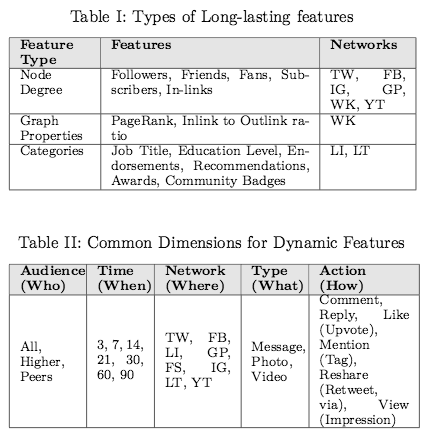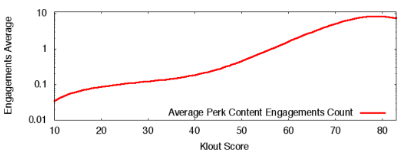 Lithium’s New Klout Score Report Reveals Methodology
Lithium’s New Klout Score Report Reveals Methodology
Klout is the premier measurement tool which analyses your social media activity through a proprietary algorithm. Your score, which is valued anywhere from 1 to 100, is based on several factors, many of which have evolved since its inception in 2008. As our image shows, your Klout score can determine how bloggers and brand ambassadors are chosen. Klout scores are used for much more – so how are the scores compiled?
Recently Lithium, which purchased Klout in 2014, released a new report on how scores are currently being calculated.
Until recently the Klout metric has been difficult to determine, and answers from Klout support do not exactly pinpoint what factors are influencing scores. Now the company is providing more details on their “methodology” in their detailed report, which outlines factors that influence a user’s score.
“Individuals can gauge their full social footprint, and brands can take advantage of this huge swath of data to better understand and engage customers in a personalized way,” Lithium stated in a recent press release. Adithya Rao, a lead engineer for Lithum, added, “Though the Klout Score has been around for years, this is the first time we have published a paper that provides this much detailed information on what’s behind it.”
How exactly do these new details reveal to brands how their influence is measured?
Here are a few points from the report to consider:
• Online and offline interactions and influence are measured
Klout is not only looking at the social activity on your social networks, but also what your brand or business is involved with offline. The report states, “The features are scalably generated by processing over 45 billion interactions from social networks every day, as well as by incorporating factors that indicate real world influence. Supervised models trained from labeled data determine the weights for features, and the final Klout Score is obtained by hierarchically combining communities and networks.” Factors can include unique interactions and behavior on each social network including daily activity, Wikipedia details and articles, news articles, and reactions from other users.
• Measurement of nine different social networks
The more social media profiles your brand or business is active on the better. This includes Facebook, Twitter, Google Plus, LinkedIn, Instagram, Pinterest, ect. But the report now reveals that each platform allows for different access. For example, Twitter provides Klout access to your public data such as tweets, retweets, mentions, ect. LinkedIn on other hand operates from a more restricted method according to their API configurations.
In a recent experiment I connected my YouTube account, which bumped my score up one percentage. However, when I connected Pinterest, my score started to decline. Your Facebook profile and page could also make the difference in your score based on these factors. Depending on where your strongest networks are you will want to test this out for a day or two before making a final decision on which social networks to keep on board with your Klout account.
A chart from the report outlines exactly what Klout is measuring on your social networks, which they divide into “long-lasting” or gradual/infrequent activity and “dynamic,” which is based on actions and reactions from users:

Dynamic interactions are important to consider in score calculations as they factor in your target market or audience, the time frame of activity and responses, which social network your interactions take place on the most, originality of content, and the type of reaction to tweets and posts. Klout still takes into account the level of influence when your information is shared or commented on, and uses this information to factor in your level of influence like this example from a recent tweet about Blab on my Twitter and Facebook accounts:

• Real-world influence
The report reveals that Klout tested users with scores of 10 to 80 in their Perks program, which is now removed from the platform. If you ever received a “perk” then you know you had the option to claim this, which often came from various sponsors from larger brand names. The report states that, “The users were encouraged, but not mandated, to post messages about their experience with the claimed perk. The users’ audiences then reacted to these messages.” Here is what they concluded from their experiment:

The study revealed that Klout users with higher scores received more reactions and were able to spread the information faster than those with lower scores. Comparisons of real-time users with higher scores are shown as a part of their study, which gathered data from top tennis players versus media personalities:

The reason for this particular study of users was that “demonstrates that the Klout score is able to capture real world influence to a high degree for these examples.”
From my own client experience, we track their client score when we begin to work with them; and, then as the months progress – using the Klout score as an indicator as to how their social programs are progressing. Without fail, the Klout scores have been a fair indicator of how their influence and reach is growing.
Google Trends also came into play for the Lithium research, which evaluated large brands like Starbucks, Fitbit, and pop star, Psy as well as the context of topics such as politics. The report states, “these examples clearly depict that Klout score can correctly identify the influencers in a variety of domains.”

The Klout methodology may still be up for debate, but one thing is clear from the report – social influence both online and offline is still a strong factor in determining your score. Like it or not, businesses and employers are increasingly looking to social measurement as a way to find out the actual influence of an individual or company. If you want to establish yourself as a trusted brand it’s important to understand exactly how your activity is being monitored in order to stand out from the rest of crowd.


0 Comments